This will be the first of a series of posts where I will share step-by-step tips for some customized online course development practices that I’ve recently attempted and found to be successful in my own online courses. Many of these tips will specifically deal with building a course in Blackboard, but the principles can certainly be applied to course design within other learning management systems.
For years, I’ve been a big fan of podcasts and have found them to be a fantastic tools for professional development as well as for fostering “presence” in my blended and online courses. As an auditory learner myself, I prefer to learn through audio in conjunction with text and have for years looked for ways to incorporate audio into my teaching. If you are brand new to podcasting, I encourage you to view this 8 minute introduction to podcasting I recorded a number of years ago as well as to read Educause’s 7 Things You Should Know About Podcasting for a background into the educational potential of podcasts.
While podcasts may not be for everyone, there is indeed no shortage of literature on podcast or evidence pointing to the educational benefits of podcasting. Here I’ve bookmarked just a few articles I’ve come across on the merits of podcasting in education.
Podcasts, whether they be audio or video, are viewable either online or a mobile device. A true podcast is far more than just an audio or video file, but also all a user to subscribe to receive new episodes automatically. For those who teach with Blackboard, there was at one time a very slick open source building block by the OSCELOT group (OSCELOT Podcaster) that replicated functionality pioneered by Learning Objects for creating and hosting podcasts directly within the course. This open source building block was broken when an institution upgraded to Blackboard Learn 9.x and at the time of this post, still isn’t yet working.
For that reason, I began several years ago experimenting with alternative approaches to creating a course podcast. My initial efforts involved creating a course podcast using Hipcast, but in search of a cheaper (ie: free) solution, I then tried using the free AudioBoo service for recording, posting, and sharing podcast episodes directly from my mobile device via the free AudioBoo app (version for iOS and Android available).
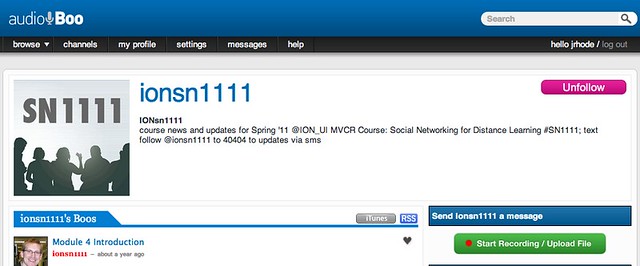
sample course podcast created using AudioBoo, available at audioboo.fm/ionsn1111
After several other approaches, none of which were much more successful, I finally came across a workflow that has worked quite well for me for creating and hosting course podcasts using Audacity, Dropbox, Feeder, and FeedBurnerwhich I will do my best to share here. The tools and workflow that I am about to share is how I have gone about creating the following course podcasts:
- Web Design Principles for Online Educators [RSS] [iTunes]
- Using Technology to Build Learning Communities [RSS] [iTunes]
- Trends and Future of Tech in Education [RSS] [iTunes]
- Social Networking in Online Learning [RSS] [iTunes]
For that sake of this tutorial, I will be using my course podcast, EDT 6030 – Using Technology to Build Learning Communities as the sample course podcast I’ll be referring to as I provide additional details.
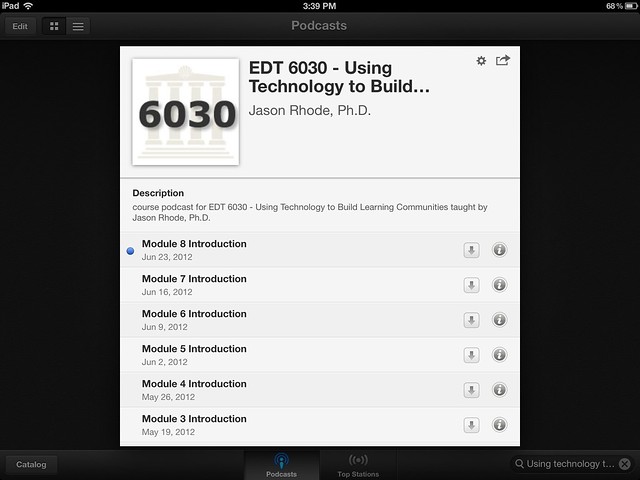
Sample course podcast found by searching in Podcasts app on iOS
Step 1: Record an Audio File (.mp3)
The very first technical task that must be completed is to simply record a file which will be the first episode of your podcast. Personally, before I record a podcast episode, I like to write a script that I read from when I record. In my course, when posting a link to the podcast episode, I include a link to the transcript for those who would prefer to read the transcript. Once I have a script, I then recording using Audacity on my computer. Audacity is a free audio recording software tool for either Mac or Windows that you can download from here. After downloading/installing Audacity, go ahead and record a sound file and export as a mp3 file. This will be your first podcast file. Save this file on your desktop.

Step 2: Setup Free Dropbox Account
If you don’t already have a free Dropbox account, click here and sign-up for your own account. Then, follow the instructions to install Dropbox on your computer(s) and setup a folder that will serve as your Dropbox. After having done so, you will locate on your computer within your Dropbox folder a “Public” folder.
**NOTE – For new accounts created after July 31, 2012, a Public folder won’t be created. Instead, individual files in any folder can be shared online. If you don’t have a Public folder, you’ll need to enable public access to that particular file.
Step 3: Create a Course Folder in Your Dropbox to Save Podcast Files to
Within your Dropbox Public folder (provided you setup your Dropbox account before July 31, 2012), create a folder for your course. I use a prefix of ~ in front of my course folders so I quickly can see which folders are course folders apart from other folders I may have.
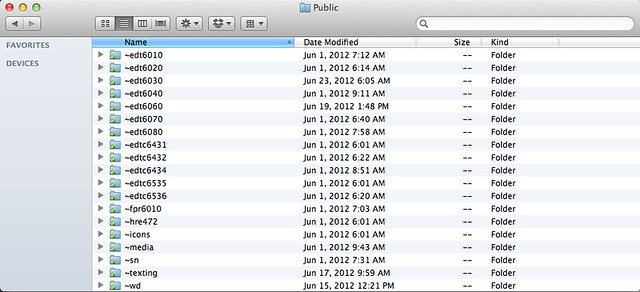
Then, save the audio file(s) already recorded for your podcast into this newly-created course folder in your Dropbox.
After doing so, when you login to your Dropbox at dropbox.com, you’ll see this folder you created on your computer automatically uploaded to your Dropbox and any files you added will also be uploaded.
Here’s a quick video tour of my public Dropbox folder where my for my course audio files are located.
Step 3: Create Podcast RSS Feed
In order for students to subscribe to your podcast, you need to have an RSS feed for your podcast that students can subscribe to. I personally use and highly recommend the software Feeder for creating and editing podcast RSS feeds on Mac. A comparable tool that works well on Windows that I’ve also used and do also recommend is FeedForAll.
Using Feeder, give your podcast a title, description, add a thumbnail, etc. Basically, just fill in the fields that Feeder prompts you to create.
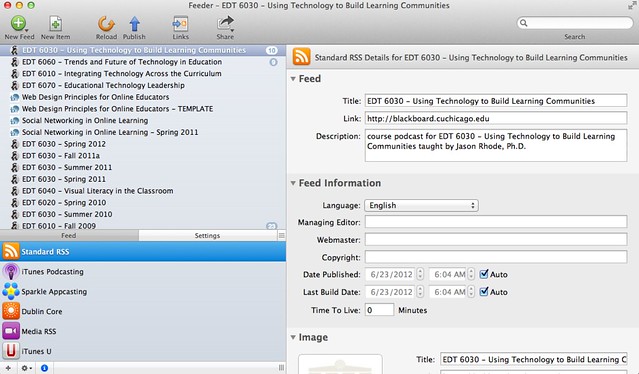
After adding feed details, then add the first episode (ie: “item”) to your podcast. To do so, you will just add a new item to the podcast feed and include the title and a description for the episode. You’ll also need to add the URL for where the episode file is located. Here’s a quick tutorial demonstrating how to create a podcast feed and add a new item.
Feeder creates a file with a .xml extension that I save within my Public folder in Dropbox, in a sub-folder I create for my course. When I save this file in my Dropbox public folder for my course, the public URL for my podcast feed then becomes: http://dl.dropbox.com/u/7112775/~edt6030/podcast.xml. Technically, this is the file that students can subscribe. However, I recommend taking the following 2 steps to create a more user-friendly RSS feed that you can also track, as well as to submit your podcast feed to iTunes if you’d like easy access to your podcast.
Step 4: Create User-Friendly and Trackable Version of Your Podcast RSS Feed Using FeedBurner
While your students can technically subscribe to the RSS feed (.xml file) at the URL for that file located in your Dropbox folder, it is preferable to instead provide students with a FeedBurner version of your feed, for the following reasons:
- A FeedBurner version of the feed is a much more user-friendly version. Compare the following two versions of the same course podcast feed:

Podcast feed XML file in native format displayed within browser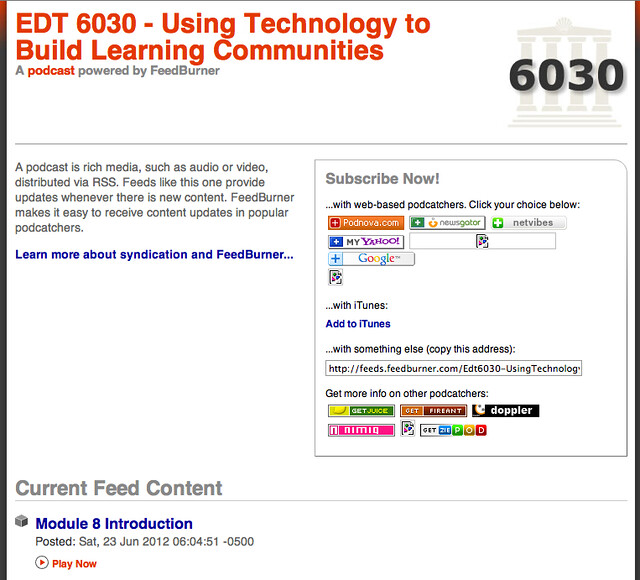
Same podcast feed, FeedBurner version displayed within the browser - If you ever decide to move your podcast .xml file to another location, if students are subscribed to the FeedBurner version, they won’t ever have to re-subscribe.
- The FeedBurner version tracks number of subscribers and downloads. So, only providing students the FeedBurner version of your podcast feed, you’ll know how many are download and how many times each episode is downloaded.
Creating a FeedBurner of your podcast feed is quick and simple! Here’s a quick tutorial demonstrating the easy steps to create a user-friendly and trackable podcast feed using FeedBurner.
Step 5: Submit Your Podcast to iTunes for Easy Access for Your Students
This is technically an optional step, but one that I go through in order to make it easy for my students to find my podcasts from within iTunes or any of the many podcasting apps on mobile devices in order to subscribe.
To submit your feed to the iTunes Store:
- Open iTunes.
- Click the green iTunes Store icon on the left side of the iTunes window.
- From the top navigation bar in the iTunes Store, click Podcasts.
- From the Podcast Quick Links section on the right, click “Submit a Podcast.”
- Follow the instructions on the Submit a Podcast page.
- Course Podcast – How to Subscribe for Students
- Module 1 Introduction Podcast Episode Transcript as HTML File
Note that you will need a valid iTunes account, and you will need to be logged into iTunes. If you are not logged in, iTunes will prompt you to enter your Apple ID and password before accepting your submission. Logging in increases the likelihood of valid contact information for each submission. You will not be charged for submitting a podcast.
If you have created an RSS feed with all of the recommended iTunes tags, you will see a summary page immediately after you submit your feed URL. If you have not included , , and tags in your feed, you will see a second screen prompting you for this information. Please note that you can change this information at a later date by including the tags in your feed. Your RSS feed is considered the current and authoritative source for information about your podcast.
Next Steps…
At this point, you’ve completed your initial setup of your course podcast…congrats! From this point forward, you simply now maintain your podcast feed, recording new episodes and adding them as new items to your podcast feed. As you do so, your students will automatically receive your new episodes in whatever podcatcher they may prefer to use.
More Samples
Here are a few more samples of podcast-related resources and samples from my experience podcasting in my courses:
Leave a comment and let me know if you found this tutorial helpful and/of if you have other questions about creating your own course podcast using these steps provided. I’d also love to take a peek at your own course podcast if you don’t mind sharing.
UPDATE 5/8/14 – I recently learned of a new tool, JustCast, that removes the previous technical hurdles and makes podcasting using Dropbox super simple! See more details here.

